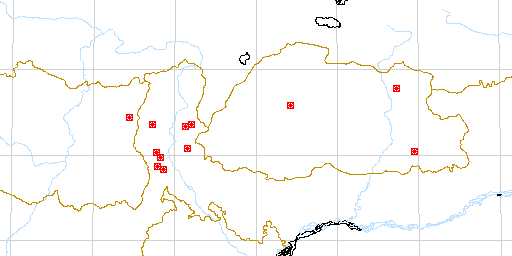
|
|
Key to species
| 1 | Leaves up to 1.5cm across, glabrous on upper surface; umbels 2–3mm diameter | H. sibthorpioides |
| + | Leaves >2cm across, usually pubescent on upper surface with thick hairs; umbels 4–15mm diameter | 2 |
| 2 | Leaves round in outline; umbels always solitary; fruiting pedicels >2mm | H. himalaica |
| + | Leaves somewhat angular in outline; umbels usually several in leaf axils; fruiting pedicels <2mm | H. nepalensis |
Hydrocotyle himalaica P.K.Mukherjee
- Hydrocotyle javanica Thunberg
var podantha C.B.Clarke non Molkenboer
Hydrocotyle podantha auct. non Molkenboer
Stems sparsely brown pubescent. Leaves orbicular in outline with 5–7 broad, shallow, very rounded lobes, (0.8–)1.5–3(–6) x 1.2–8cm, margins crenate-dentate, sparsely strigose pubescent on both surfaces; petioles 1–18cm, densely pubescent near apex. Umbels solitary in leaf axils, to 13mm across in fruit; peduncles 1.5–10cm, usually as long or longer than the petioles of the subtending upper leaves; pedicels (2–)4–7mm in fruit. Petals narrowly triangular greenish cream, 1–1.3mm, slightly incurved at apex. Styles persistent, spreading in fruit (0.6–)0.8–1mm long. Fruit c 1 x 1.5mm.
Bhutan: S—Chukka district (Chukka Bridge)
and Deothang district (Keri Gompa); C—Mongar district (Tashigang
to Mongar);
N—Upper Kuru Chu district (Denchung).
Sikkim: Bitu, Gangtok, Karponang, Labdah, Penlang
La, Yoksam.
Darjeeling: Chunabate, Darjeeling, Kurseong, Mungpoo,
Senchal.
Ecology: Damp shady areas, banks in forests, streamsides,
etc. 1500–2450m.
Flowers April–September.
Illustration[ Fig 48 a–d]
Specimen List [7593]

Distribution Map for Hydrocotyle
himalaica P.K.Mukh. in the East Himalayan Region
[complete records for Bhutan, Chumbi, Sikkim and Darjeeling,
partial data for East Nepal]
Hydrocotyle nepalensis Hook.f.
- Hydrocotyle hispida D.Don
Hydrocotyle javanica sensu F.B.I. pp.
Hydrocotyle polycephala Wight & Arnott
Bhutan: S—Chukka district (Chukka, Chukka
Bridge), Deothang district (Samdrup Jongkhar) and Gaylegphug district (Aie
Bridge, Gaylegphug to Shemgang) districts; C—Punakha district (Lobesa
to Lomentsawa, Shenganga) and Mongar district (Shongar).
Sikkim: Badamtan, Damthang–Temi, Gangtok, Hi,
Pemayangtse–Thingling, Rimbi, Sirong.
Darjeeling: Birch Hill, Ghum, Kali, Kalimpong,
Lebong, Senchal, Takvar.
Ecology: Damp shady areas, banks in forests, streamsides,
etc. 500–2500m.
Flowers May–July.
Specimen List [7482]
Note: This species and H. himalaica are very closely related and poorly understood. They, and the other members of the H. javanica complex need further study on a worldwide scale.
Hydrocotyle sibthorpioides Lamarck
- Hydrocotyle rotundifolia DC.
Hydrocotyle tenella D.Don
Bhutan: S—Samchi district (Daina Khola)
and Gaylegphug district (Norbuling); C—Thimphu district (Simtokha–Dochu
La), Punakha district (Punakha Dzong) and Tongsa district (Tongsa).
Darjeeling: Birik, Char Churabhandar, Siliguri,
Takdah.
Ecology: Damp shady areas, banks in forests, streamsides,
etc. 300–2350m.
Flowers March–May.
Specimen List [7533]
Note: Plants with leaves pubescent below may be distinguished as forma pilosa Hara.